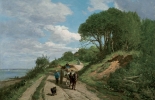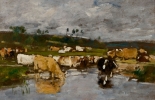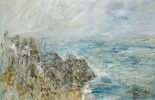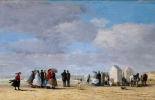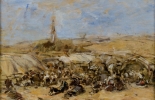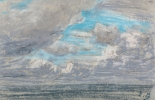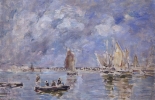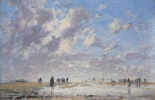Eugène Boudin, l’atelier de la lumière
from April 16 to September 26, 2016
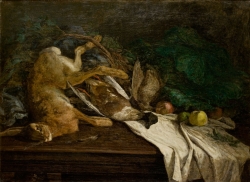
Eugène BOUDIN (1824-1898), Game and Fruit on a Table, ca. 1854-1857, oil on canvas, 72 x 98 cm. © MuMa Le Havre / Florian Kleinefenn
In 1860, the City of Le Havre purchased the first of Boudin's works to be exhibited in the Paris Salon: The Pardon of Sainte-Anne-la-Palud in the Bay of Douarnenez (Finistère), for the sum of 500 francs. The last Boudin to be purchased by the City was Deauville Basin, around 30 years later. A set of 10 drawings and a watercolour of "views of old Le Havre" joined the collections in 1891.
Finally, in 1893, the widow of Boudin's trusty friend Ferdinand Martin donated two small panels depicting the harbour entrance of Le Havre to the museum.
On the artist's death in 1898, the museum owned seven paintings, ten drawings and one watercolour by Boudin, almost all of them youthful works.
Boudin, who had no descendants, made plans for what would happen when he died. He decided to give the painting Still Life with Fish, 1873 and one or two other additional works, to be chosen by his friends, to the museum. Two years later, in 1900, not one or two but 240 works were donated by the artist's brother, Louis Boudin, on the advice of Gustave Cahen, the executor of the painter's will. Louis Boudin lived in Le Havre, and his attachment to the city probably had a bearing on this decision, but the crucial factor was Gustave Cahen's determination to serve the artist's memory and ensure that his work had pride of place in France's public collections. It is thanks to Cahen that the Musée d’Orsay has such a huge archive of drawings (nearly 6,400).
The "240 studies on canvas and boards" are recorded in the inventory of Le Havre's Museum of Modern Art under a single number. All of them came from the artist's studio. Including works that he kept to the last, unsold works and very late sketches from the end of his life, they illustrate a lifetime of artistic endeavour and exploration.
Oddly, as it now seems to us, during the period between the wars, the collection acquired some works by Boudin while allowing others to pass out of its hands, selling eight paintings and enlarging its collection of "77 drawings and sketches by Eugène Boudin".
Since then, the collection has continued to grow as a result of art-lovers' generosity. In 1936, the merchant Charles-Auguste Marande, who was a founding member of the Cercle de l’Art Moderne, bequeathed his collection to the museum. It included a work by Boudin, Trouville Harbour Entrance. Almost 70 years later, in 2004 and 2005, 28 more works (oil paintings and watercolours) from the collection of Olivier Senn, also a merchant, art-lover and member of the Cercle de l’Art Moderne, were added to the Boudin archive, thanks to the generosity of his granddaughter Hélène Senn-Foulds and his grandson-in-law Pierre-Maurice Mathey. These donations demonstrate both that Boudin's works featured prominently in Le Havre's private collections and that these art-lovers played an important part in the artist's life.


